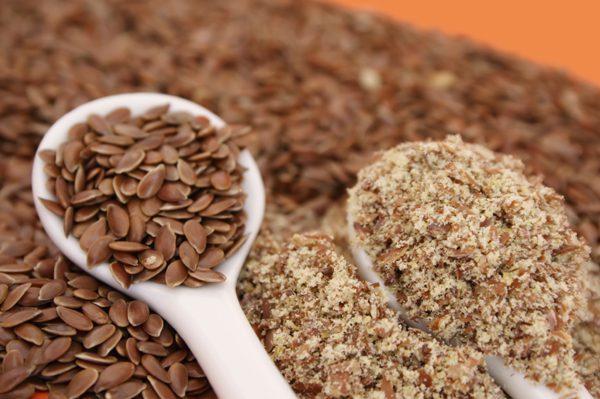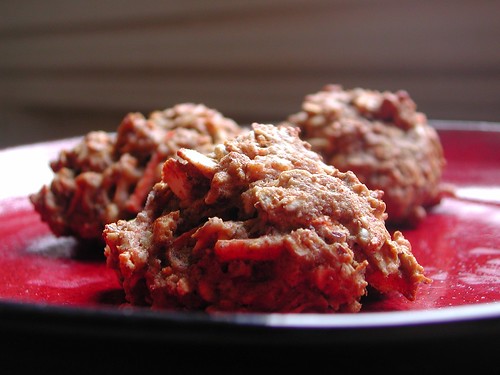Lately the media has been spending alot of time talking about “healthy omega 3 fats.” And it’s about time! Most people are woefully deficient – getting only about 1/3 of what’s recommended.
However, as usual with media saturation, the finer points are often lost. For example, the following questions (and those like them) often go unanswered.
Are all omega 3s the same?
If I take flax, should I take fish oil – and vice versa?
How much omega 3 should I take?
And so on…
Therefore, in this newsletter, rather than discussing all the different types of healthy fat available today, we’re going to narrow in on flax seeds.

The flax primer
Now, most of you are likely familiar with flax seeds and flax oil. And your knowledge likely resides somewhere between “flax is good for me” to “flax has alpha linolenic acid, which can be converted to the powerful fatty acid, EPA”.
Regardless of your pre-existing knowledge, here’s a little primer.
Primarily, flax contains alpha-linolenic acid, an omega-3 fatty acid. ALA falls under the subheading of polyunsatured fat.
Humans evolved on diets consisting of marine life and/or inland plants which provided abundant omega-3 fats. This resulted in an omega-6/omega-3 ratio that was around 1:1.
Currently, humans don’t get nearly enough omega-3 fats from things like flax, hemp, walnut, perilla, salba, and fish oil. As a result, most people consume a ratio of about 16:1 – an intake that’s out of balance.
Therefore, purposefully adding omega-3 rich fats has become not only popular, but necessary. And the two most popular omega 3 foods are flax seeds and fish oil.
The benefits of flax
While we’ve spoken extensively about fish oil on this site, we figured it was time to list some of the unique benefits of flax – specifically flax seeds.
Constipation
- 2 tablespoons of flaxseeds has been shown in research studies to alleviate constipation.
- So, if you’re suffering from infrequent bowel movements, you can add 2 tbsp of flax to improve things.
- This is much less expensive than fiber supplements.
- Also, the calorie load is low. 2 tbsp = 80 calories (6g fat, 4g carbs, and 4g protein).
Flax to EPA
- Flax has ALA, which can be converted to EPA.
- For this conversion, we need delta-6-desaturase.
- Well, good old delta-6 is inhibited by high blood sugar levels, high saturated fat consumption, and alcohol intake.
- So if your diet is poor, flax won’t do you much good when it comes to converting into the really healthy omega 3 fats.
Menopause
- 4 tablespoons of flaxseeds per day can halve the amount of hot flashes in post menopausal women.
- This same dose can lessen the severity of hot flashes by about 50%.
Dry eye syndrome
- This is one of the most common problems treated by eye eye docs.
- Dry Eye Syndrome is caused by poor lubrication of the eye, leading to burning, itching, irritation, redness, blurred vision the improves with blinking, excessive tearing, discomfort after periods of watching TV or working on a computer.
- Interestingly, people that consume more omega-3 fats (from flax) have a lower incidence of dry eye syndrome.
Reduced cholesterol
- Those that consumed 3 tablespoons of ground flaxseeds per day for 60 days had significant reductions in total cholesterol, bad cholesterol, and triglycerides.
- These improvements are similar to those seen when taking the powerful statin drugs (which carry with them some nasty side effects).
Flax in your diet
Now, while these benefits are groovy, I find that many folks simply don’t know how to include flax in their diet.

Here are some great suggestions:
- Combine ground flax with cinnamon and use as a dip for fruit (like apples)
- Sprinkle ground flax over berries
- Mix ground flax in super shakes
- Add ground flax to whole grain cereals
- Add ground flax to salads
- Add ground flax to salad dressing
- Sprinkle on cooked vegetables
- Add ground flax to hummus
- Add ground flax to nut butters
- Combine flax and cinnamon to canned pumpkin
- Add to Gourmet Nutrition recipes like pancakes, bars, cookies, muffins
In fact, here’s one great recipe, right from our new book, Gourmet Nutrition – The Cookbook For the Fit Food Lover, that incorporates flax seeds.
Gooey Chocolate Chip Muffins
Servings
6 large or 12 small
Prep time
10 minutes
Cooking time
10 minutes
Prelude
Everybody loves chocolate chip muffins. So even though they’re a decadent treat, we decided to include a GN version here, including a variety of ingredients designed to improve the overall nutritional profile of the classic muffin mix. Be forewarned, however. These muffins are still high in calories and in carbs. So you’ll want to make sure to earn them in the gym and eat them post exercise.
Ingredients
1/2 cup unsalted butter (room temperature)
4 whole omega 3 eggs
¼ cup coconut milk
1 teaspoon vanilla extract
1 1/2 cups whole-wheat flour
1/2 cup flax meal
6 scoops chocolate protein powder
1 tablespoon cocao powder
1 teaspoon baking powder
1 teaspoon Splenda
½ cup chocolate chips
½ cup dried fruit
Instructions
Preheat oven to 350 degrees F.
Combine all ingredients together in a mixing bowl and stir with a wooden spoon until combined.
Lightly coat a nonstick muffin pan with spray and then fill each muffin almost to the top.
Place in the oven and bake 10 minutes or until the top is set.
Cool, portion and store in the freezer individually wrapped.
Variations and options
Substitute the dried fruit in this recipe with seeds or crushed nuts.
For some additional healthy fat, slice and coat with natural almond or peanut butter.
Nutritional information
Available in Gourmet Nutrition – The Cookbook For The Fit Food Lover. To pick up your copy, click here.

Too much flax?
Ok, now that you know how to incorporate flax into your plan, the big question is this: can you eat too much? The answer: of course. Just like with every other food – overconsumption can be a problem.
Raw flaxseeds, along with other nuts/seeds (about 12,000 of them) contain cyanogenic glucosides. Consuming too many of these compounds over time can cause an accumulation in the body and toxic (even life threatening) reactions.
So, how much is too much? Well, up to ¼ cup per day of ground flax should pose no health risks. Further, as cooking the seeds will render the glucosides harmless, you could cook your flax seeds (in your baked items, for example).
What about fish oil
A discussion of fish oil is beyond the scope of this week’s newsletter. Instead, we’re focusing on flax. However, if you’d like to know more about the other healthy fats and/or fish oil specifically, take a look in our forum area.
Additional flax info
Before we wrap up, we wanted to drop a few more notes about flax:
- Golden flax tends to have a mild flavor and is preferred by some.
- Flax oil can be used to boost omega-3 fat intake as well, but it’s lacking the fiber and protein – plus, its not a whole food so we prefer supplementing with fish oil and eating flax seeds.
- Flax seeds (but not the oil) contain lignans, a class of phytoestrogens. These lignans act as antioxidants and may be responsible for some of the other health benefits attributed to flax consumption. (No worries, though, you’ll not become “estrogenic” from consuming flax.
- When someone eats the whole flax seed (un-ground) it will not be absorbed by the body. Therefore it needs to be ground first.
Learn more
Want to get in the best shape of your life, and stay that way for good? Check out the following 5-day body transformation courses.
The best part? They're totally free.
To check out the free courses, just click one of the links below.




Share